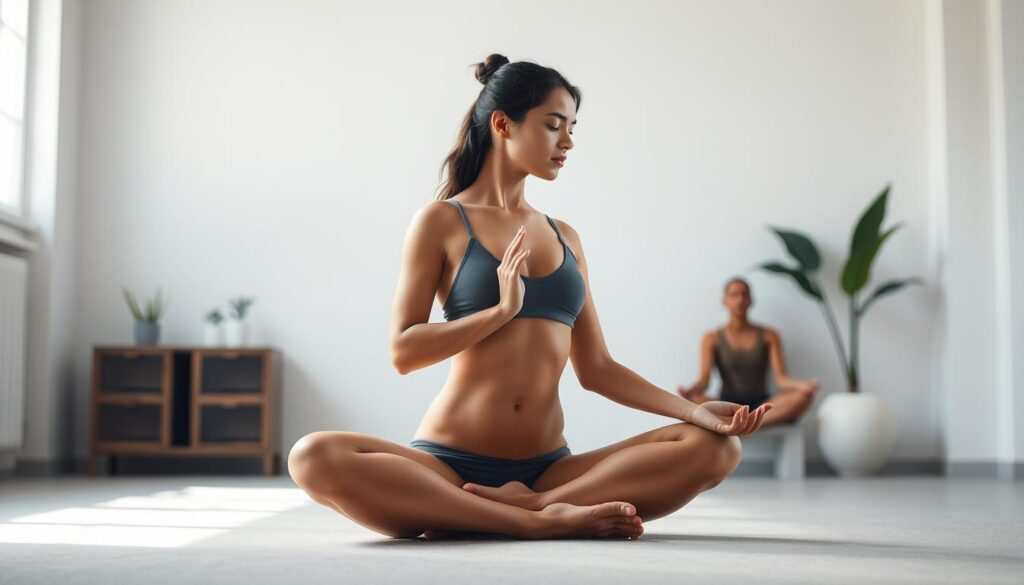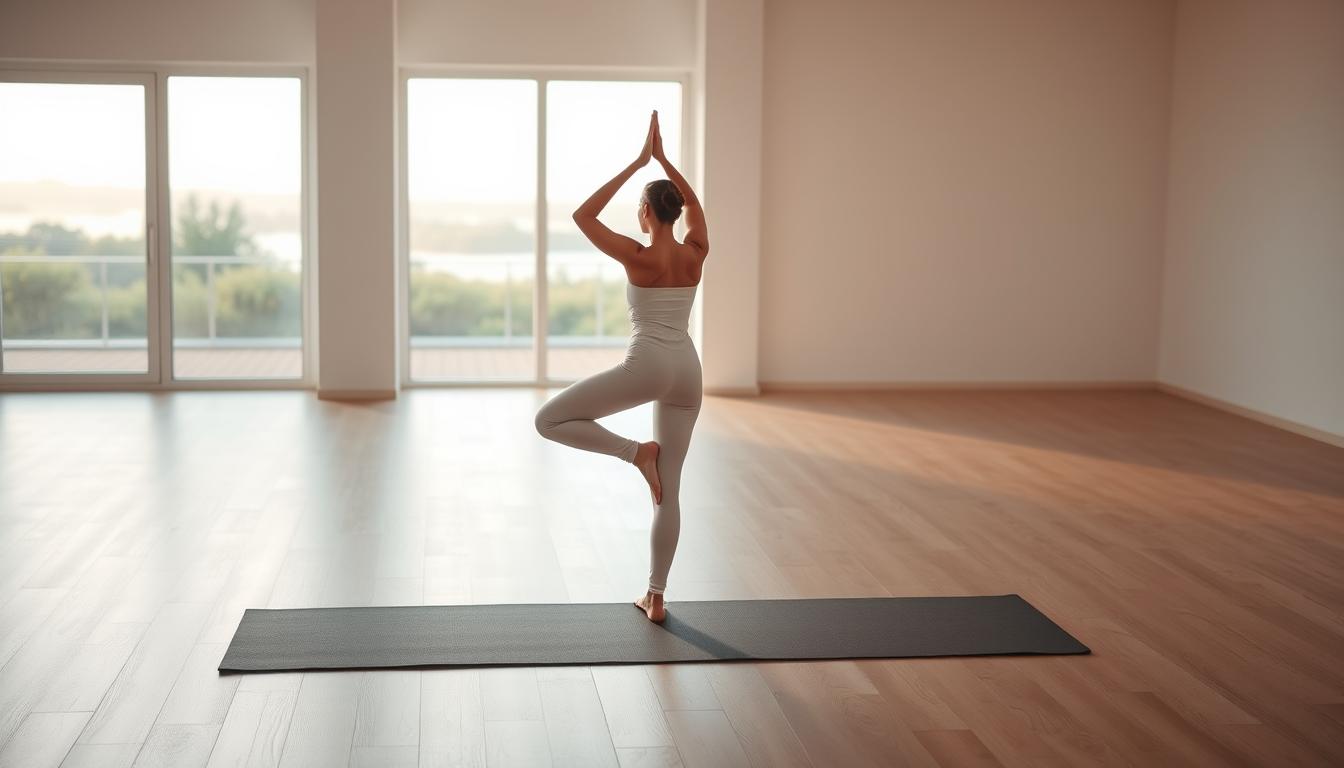Did you know that regular physical activity can be as effective as medication in treating mild to moderate depression1? This surprising fact highlights the powerful connection between the body and the brain. By combining physical activity with mindfulness, individuals can unlock a holistic approach to well-being.
Mindful movement is more than just staying active. It’s about tuning into your body and being present during every motion. This practice helps reduce stress, release tension, and improve overall health1. Activities like yoga or tai chi, for example, can ground individuals and alleviate anxious thoughts1.
By focusing on both the body and the mind, this approach fosters clarity, balance, and resilience. It’s a powerful way to enhance physical performance while nurturing mental well-being. Whether it’s through deep breathing or post-workout reflection, mindful movement encourages continuous growth and mindfulness in fitness journeys1.
Key Takeaways
- Regular physical activity can reduce stress hormones like cortisol1.
- Mindful movement connects the body and brain for better well-being.
- Activities like yoga and tai chi help alleviate anxious thoughts1.
- Deep breathing calms the nervous system during physical activity1.
- Post-workout reflection strengthens the mind-body connection1.
Understanding the Benefits of Mindful Movement
The connection between physical activity and mental clarity is stronger than you might think. By integrating awareness into your routines, you can unlock a range of health benefits. This approach not only improves physical flexibility but also reduces stress and enhances emotional stability2.
Impact on Physical Health and Flexibility
Practices like yoga and stretching are proven to enhance flexibility and reduce muscle tension. Research shows that these activities can significantly improve mobility, especially for individuals dealing with chronic pain2. By focusing on breath and movement, you can gradually increase your range of motion and overall physical performance.
For example, yoga has been shown to improve posture, strength, and confidence in everyday activities2. This makes it a valuable tool for maintaining long-term physical health. Regular engagement in such practices can lead to lasting benefits over time.
Enhancing Mental Clarity and Stress Reduction
Mindful activities like yoga and stretching also play a crucial role in reducing stress. By focusing on the present moment, these practices help calm the nervous system and alleviate anxious thoughts2. Studies indicate that mindfulness during physical routines can improve both active and passive movements, contributing to better mental and physical performance2.
Additionally, building a nighttime routine that includes meditation and stretching can enhance sleep quality2. This further supports emotional stability and overall well-being. The combination of physical activity and mental focus creates a powerful tool for stress management.
“Mindfulness during physical routines can transform both your body and mind, offering a holistic approach to health.”
| Benefit | Description |
|---|---|
| Improved Flexibility | Enhances range of motion and reduces muscle tension2. |
| Stress Reduction | Calms the nervous system and alleviates anxious thoughts2. |
| Better Sleep | Incorporating mindfulness into nighttime routines improves sleep quality2. |
By integrating mindful practices into your daily routine, you can experience significant improvements in both physical and mental health. These activities offer a balanced approach to well-being, making them a valuable addition to any lifestyle.
The Science Behind Mindful Exercise
Recent studies reveal how combining mindfulness with physical activity strengthens the brain-body connection. This synergy enhances both mental clarity and physical efficiency, offering measurable benefits for overall well-being3.
Research shows that mindfulness practices during physical routines can significantly improve neural pathways. For example, a systematic review of 35 studies found that combining these approaches reduces symptoms of depression, anxiety, and stress3. These findings highlight the importance of integrating awareness into daily routines.
Research Findings on Brain-Body Connections
Controlled breathing plays a key role in syncing physical movement with mental focus. Studies indicate that this practice calms the nervous system and enhances cognitive function4. By focusing on breath, individuals can achieve greater mental clarity during exercise.
Methodologies used in these studies often measure changes in brain structure and activity. For instance, research has shown that mindfulness practices increase gray matter volume in areas like the prefrontal cortex and hippocampus4. These changes are linked to improved emotional stability and physical performance.
“The combined benefits of mindfulness and physical activity are rooted in improved biomarkers related to neuroinflammation and mood states.”
Regular practice is essential to achieve these benefits. Studies suggest that consistent engagement in mindful routines leads to lasting improvements in both neural function and physical efficiency3. This makes mindfulness a valuable tool for long-term health.
Mindful Movement: Exercise Strategies for Both Body and Brain Health
Integrating awareness into physical routines can transform both mental focus and physical performance. By paying attention to bodily sensations and breathing, individuals can amplify the benefits of their workouts. This approach fosters a deeper connection between the mind and body, enhancing overall well-being5.
One effective strategy is to slow down during workouts. This allows athletes and enthusiasts to cultivate a sense of internal awareness. For example, focusing on the rhythm of breath during a run or the alignment of posture during yoga can lead to greater mental clarity and physical efficiency6.
Maintaining attention on bodily sensations also plays a key role in injury prevention. By tuning into the body’s signals, individuals can avoid overexertion and promote long-term wellness. Practices like tai chi and yoga are excellent examples of activities that blend physical movement with mental focus5.
“Slowing down and focusing on the present moment during physical activity can lead to a more enjoyable and effective workout experience.”
Here are some exercises that incorporate both physical movement and mental focus:
- Yoga: Enhances flexibility while promoting mental calmness.
- Tai Chi: Combines slow, deliberate movements with deep breathing.
- Walking Meditation: Encourages presence and awareness with each step.
By integrating these practices into daily routines, individuals can experience significant improvements in both physical and mental health. The role of awareness in promoting overall wellness cannot be overstated6.
Techniques for Enhancing Body Awareness
Developing body awareness is a powerful way to improve both physical and mental health. By tuning into bodily sensations, individuals can better understand their needs and respond effectively. This practice not only enhances physical performance but also supports emotional well-being7.

Tuning Into Physical Sensations
One effective way to enhance body awareness is through slow, deliberate movements. Activities like yoga and tai chi encourage individuals to focus on each motion, fostering a deeper connection to their bodies7. This approach helps identify areas of tension and promotes relaxation.
Breathing plays a crucial role in this process. By paying attention to the rhythm of breath, individuals can detect muscle tension and adjust their movements accordingly8. This mindful practice not only improves physical flexibility but also calms the mind.
Recognizing and Releasing Tension
Body scan meditation is another effective technique for recognizing and releasing tension. This practice involves mentally scanning the body from head to toe, identifying areas of stress, and consciously relaxing them8. Studies show that this method can reduce pain and improve sleep quality7.
Incorporating balance exercises, such as standing on one leg or using a stability ball, can also enhance body awareness. These activities activate the proprioceptive and vestibular systems, improving coordination and reducing the risk of injury7.
“Focusing on physical sensations and breathing can transform the way we experience movement, leading to greater mental clarity and physical ease.”
By integrating these techniques into daily routines, individuals can build a stronger connection to their bodies. This awareness supports mental health by providing a clearer understanding of internal sensations and promoting overall wellness8.
Incorporating Yoga and Stretching into Your Routine
Yoga and stretching are more than just physical activities; they are gateways to improved flexibility, reduced tension, and enhanced mindfulness. These practices allow a person to connect deeply with their body, fostering a sense of balance and well-being9.
Regular yoga practice can significantly improve flexibility, with studies showing a 20% increase over three months10. This enhanced range of motion helps reduce stiffness and prevent injuries, making it a valuable addition to any fitness routine9.
Guided Yoga Practices for Mindfulness
Guided yoga sessions are particularly effective in building strength and reducing bodily tension. A study found that 80% of practitioners reported improved flexibility and mobility as a primary benefit11. These sessions often incorporate mindfulness techniques, helping individuals feel more present and focused.
For beginners, starting with 10-15 minutes of yoga daily is recommended. Consistency is key, as even short sessions can lead to long-term benefits9. Practices like Mountain Pose and Downward-Facing Dog are excellent for improving posture and balance9.
“Yoga not only strengthens the body but also calms the mind, offering a holistic approach to health.”
Deliberate stretching plays a crucial role in facilitating better body mechanics. Dynamic stretching before yoga sessions can improve muscle activation by 30%, enhancing overall performance11. This practice also helps a person recognize and release tension, promoting relaxation and mental clarity9.
Here are some tips for integrating yoga and stretching into daily routines:
- Start small: Begin with short sessions and gradually increase duration.
- Focus on breath: Use controlled breathing to enhance mindfulness and reduce stress9.
- Join a class: Group sessions foster a sense of community and motivation10.
By incorporating these practices, individuals can experience significant improvements in both physical and mental health. The combination of yoga and stretching offers a balanced approach to well-being, making it a valuable addition to any lifestyle11.
Walking Meditation as a Form of Mindful Movement
Walking meditation offers a unique way to combine physical activity with mental focus, creating a harmonious balance. Unlike regular walking, this practice encourages individuals to anchor their attention in the present moment, fostering a deeper connection between the body and mind12.

Step-by-Step Walking Meditation
To begin, find a quiet space where you can walk without distractions. Start by standing still, taking a few deep breaths to center yourself. As you start walking, focus on the sensation of each step—how your feet touch the ground and lift again13.
Pay attention to your breathing, syncing it with your steps. For example, inhale for three steps and exhale for three steps. This rhythm helps anchor your mind in the present moment, reducing stress and enhancing mental clarity12.
If your mind wanders, gently bring your focus back to your steps or breath. Research shows that even short sessions of this practice can improve attention and overall well-being14.
Anchoring Attention in Everyday Steps
Walking meditation isn’t limited to designated sessions. It can be integrated into daily routines, such as walking to work or taking a stroll in the park. By focusing on the sensations of movement and the environment, individuals can break the cycle of stress and distraction13.
Studies indicate that this practice enhances mood by shifting perception from a “negativity bias” to a more positive outlook14. Observing changes in the environment, like the rustling of leaves or the warmth of the sun, can further deepen this sense of awareness12.
“Walking meditation transforms ordinary steps into moments of mindfulness, offering a simple yet powerful tool for mental and physical well-being.”
| Benefit | Description |
|---|---|
| Improved Mood | Shifts perception to a more positive outlook14. |
| Enhanced Focus | Anchors attention in the present moment, reducing distractions12. |
| Stress Reduction | Breaks the cycle of stress by focusing on physical sensations13. |
By incorporating walking meditation into daily life, individuals can experience significant improvements in both mental clarity and emotional well-being. This practice offers a simple yet effective way to stay present and cultivate mindfulness in every step14.
Mindful Breathing Practices to Enhance Your Workout
Breathing techniques are a powerful tool to enhance both mental focus and physical performance during workouts. By incorporating specific practices, individuals can stabilize their mind and body, leading to better results and reduced stress15.
Box Breathing Techniques
Box breathing is a simple yet effective method to calm the mind and improve focus. This technique involves four steps: inhale for four counts, hold for four counts, exhale for four counts, and hold again for four counts16.
This rhythmic pattern helps regulate the nervous system, reducing symptoms of anxiety and promoting mental clarity17. Studies show that box breathing can increase heart rate variability, a key indicator of stress resilience15.
Here’s how to practice box breathing:
- Inhale: Slowly breathe in through the nose for four counts.
- Hold: Pause and hold the breath for four counts.
- Exhale: Release the breath through the mouth for four counts.
- Hold: Pause again for four counts before repeating.
Alternate Nostril Breathing Mechanics
Alternate nostril breathing is another technique that balances the mind and body. This practice involves using the thumb and ring finger to alternate airflow between the nostrils16.
Research indicates that this method can reduce anxiety and improve focus by calming the nervous system17. It’s particularly effective for managing stress during intense workouts or recovery sessions15.
Follow these steps to practice alternate nostril breathing:
- Step 1: Sit comfortably and close the right nostril with the thumb.
- Step 2: Inhale through the left nostril for four counts.
- Step 3: Close the left nostril with the ring finger and exhale through the right nostril for four counts.
- Step 4: Repeat the process, alternating nostrils for 5-10 minutes.
“Breathing techniques like box breathing and alternate nostril breathing can transform your workout experience, offering both mental clarity and physical stability.”
By integrating these practices into your routine, you can enhance your workout performance and build mental resilience. These techniques are simple yet powerful tools for managing stress and staying focused17.
Integrating Mindfulness into High-Intensity and Recovery Workouts
High-intensity workouts demand both physical effort and mental resilience, making mindfulness a key component for success. By staying present, individuals can regulate their emotions and maintain focus, even during the most challenging routines18. This approach not only enhances performance but also ensures a balanced recovery process.
Staying Present During Intense Exercise
Maintaining mindfulness during high-intensity workouts can significantly improve the experience. Short meditation sessions of 5-10 minutes before starting can enhance focus and reduce performance anxiety18. This practice helps individuals tune into their feelings and bodily sensations, allowing them to push their limits safely.
For example, focusing on breathing patterns during sprints or weightlifting can anchor the mind in the present day. This technique reduces distractions and helps regulate emotions, leading to better results19.
Mindful Recovery Practices
Recovery is just as important as the workout itself. Incorporating mindfulness into this phase can reduce the likelihood of injury by promoting better body awareness18. Practices like deep breathing or gentle stretching help the body repair and prepare for the next session.
Studies show that mindful recovery decreases cortisol levels, contributing to stress reduction and improved overall well-being18. Tuning into one’s feelings during rest ensures a holistic approach to fitness.
“Mindfulness during high-intensity workouts transforms the experience, offering both mental clarity and physical stability.”
| Technique | Benefit |
|---|---|
| Pre-Workout Meditation | Enhances focus and reduces anxiety18. |
| Breathing Awareness | Regulates emotions and improves performance19. |
| Post-Workout Stretching | Promotes recovery and reduces injury risk18. |
By integrating these mindful techniques, individuals can achieve a balanced approach to high-intensity workouts and recovery. This ensures long-term benefits for both physical and mental health19.
Building Resilience Through a Mind-Body Connection
Building resilience through a strong mind-body connection can transform how we handle stress and physical challenges. By focusing on posture and alignment, individuals can reduce both physical and emotional tension, fostering a sense of empowerment20.
Posture and Emotional Empowerment
Proper posture is more than just standing tall; it’s a gateway to emotional stability. Studies show that maintaining good alignment during a workout can reduce tension and improve overall performance21. This connection between posture and mental clarity is key to building resilience.
Here are some ways mindful practices enhance posture and core strength:
- Alignment Awareness: Focusing on posture during movement helps identify areas of tension20.
- Core Engagement: Strengthening the core supports better alignment and reduces strain22.
- Breath Synchronization: Coordinating breath with movement enhances stability and focus21.
Short, focused mindful minutes can make a big difference. Taking a moment to check alignment during a workout fosters emotional empowerment and physical relief20.
“Intentional movement and proper posture alignment are foundational to building resilience and reducing stress.”
By integrating these techniques, individuals can strengthen their mind-body connection, leading to improved workout performance and overall well-being22.
Practical Tips and Daily Routines for Mindful Movement
Establishing a daily routine that incorporates mindful practices can significantly enhance both physical and mental well-being. By focusing on consistency and minimizing distractions, individuals can build a strong mind body connection that supports overall health23.
Creating a Consistent Practice Schedule
Consistency is key to developing a sustainable routine. Start by setting aside 10-15 minutes daily for mindful activities like stretching or yoga. These practices improve muscle awareness and flexibility while fostering emotional stability24.
To maintain consistency, align your practice with existing habits. For example, integrate mindful breathing into your morning routine or take a short walk during lunch breaks. This approach ensures that mindful movement becomes a natural part of your life25.
Here are some tips for building a consistent schedule:
- Set reminders: Use apps or alarms to prompt your practice.
- Start small: Begin with short sessions and gradually increase duration.
- Track progress: Keep a journal to monitor improvements and stay motivated23.
Overcoming Distractions in Daily Life
Distractions can hinder progress, but simple strategies can help. Designate a quiet space for your practice, free from interruptions. This creates a focused environment that enhances the mind body connection24.
Limit screen time before and after your sessions to maintain mental clarity. Research shows that reducing digital distractions improves focus and reduces stress25.
Incorporate mindful moments throughout the day. For example, practice deep breathing while waiting in line or focus on posture during work tasks. These small adjustments build resilience and keep you grounded23.
“Consistency and focus are the cornerstones of a successful mindful movement practice, offering long-term benefits for both body and mind.”
| Strategy | Benefit |
|---|---|
| Designated Space | Reduces distractions and enhances focus24. |
| Screen Time Limits | Improves mental clarity and reduces stress25. |
| Mindful Moments | Builds resilience and keeps you grounded23. |
By integrating these practical tips into your life, you can create a sustainable routine that supports both physical and mental health. The key is to stay consistent and minimize distractions for long-term success24.
Conclusion
Transforming daily habits with intentional practices can lead to profound improvements in overall well-being. Integrating these techniques into your routine fosters better blood circulation, flexibility, and resilience. Studies show that consistent practice enhances mental clarity and reduces stress, creating a balanced approach to health26.
By focusing on intention, individuals can achieve lasting change in their physical and emotional states. Activities like yoga and walking meditation not only improve physical health but also support emotional stability27. These practices encourage a deeper connection between the mind and body, promoting long-term wellness.
Start small by dedicating a few minutes each day to these techniques. Over time, this routine will become a sustainable lifestyle change, offering benefits like improved blood flow and reduced tension. Embrace these practices with intention to unlock a healthier, more balanced life.
FAQ
What is mindful movement, and how does it benefit health?
How does mindful movement impact mental clarity?
What scientific evidence supports the brain-body connection in mindful exercise?
How can I tune into physical sensations during mindful movement?
What are the benefits of incorporating yoga into a mindful routine?
How does walking meditation work as a mindful practice?
What are some effective breathing techniques for mindful workouts?
How can I stay present during high-intensity workouts?
How does posture influence emotional resilience in mindful movement?
What are practical tips for maintaining a consistent mindful movement routine?
Source Links
- Mindfulness and Movement: The Connection Between Body and Mind in Exercise – https://fitness.edu.au/the-fitness-zone/mindfulness-and-movement-the-connection-between-body-and-mind-in-exercise/
- Mindful Movement | SBM – Society of Behavioral Medicine – https://www.sbm.org/healthy-living/mindful-movement
- Exercise combined with mindfulness helps improve depression, anxiety – https://www.medicalnewstoday.com/articles/exercise-combined-with-mindfulness-improves-mental-health
- Effects of Mind–Body Exercise on Brain Structure and Function: A Systematic Review on MRI Studies – https://pmc.ncbi.nlm.nih.gov/articles/PMC7915202/
- Getting Started with Mindful Movement – https://www.mindful.org/getting-started-with-mindful-movement/
- 9 Mindfulness Exercises for Stress Relief, Mental Health, and More – https://www.onepeloton.com/blog/how-to-practice-mindfulness-during-exercise/
- Body Awareness: How to Deepen Your Connection With Your Body – https://www.healthline.com/health/mind-body/body-awareness
- Can mindfulness exercises help me? – https://www.mayoclinic.org/healthy-lifestyle/consumer-health/in-depth/mindfulness-exercises/art-20046356
- Mindful Movement: Incorporating Yoga and Meditation into Your Fitness Routine – https://hbrpersonaltraining.com/blog/mindful-movement-incorporating-yoga-and-meditation-into-your-fitness-routine
- How to Incorporate Body & Brain Yoga Tai Chi into Your Daily Routine – https://www.bodynbrain.com/blog/body/incorproate-yoga-into-your-daily-routine/5407
- Incorporating Yoga into Your Fitness Routine for Mind-Body Wellness – Nobility Chiropractic & Wellness – https://nobilitychiropractic.com/incorporating-yoga-into-your-fitness-routine-for-mind-body-wellness/
- Walking Meditation (Greater Good in Action) – https://ggia.berkeley.edu/practice/walking_meditation
- Walking Meditation’s 7 Benefits for Mood, Sleep & More – https://www.healthline.com/health/walking-meditation
- 6 Ways to Enjoy Mindful Walking – https://www.mindful.org/6-ways-to-get-the-benefits-of-mindful-walking/
- Mindfulness Breathing Exercises: Guide to Techniques and Benefits – https://mindfulnessexercises.com/6-mindful-breathing-exercises/
- Need to Chill? Try These 9 Breathing Exercises to Relieve Anxiety Quickly Now – https://www.verywellmind.com/abdominal-breathing-2584115
- Breathwork Meditation: Benefits, Exercises, and Tips – https://www.healthline.com/health/breath-work-meditation
- Integrating Meditation with Exercise – SVG3 Fitness – https://svg3fitness.com/blog-post/mindfulness-and-movement-integrating-meditation-with-exercise/
- How to incorporate more joyful exercise in your life – https://www.bswhealth.com/blog/mindful-movement-how-to-incorporate-more-joyful-exercise-in-your-life
- Building Mental Resilience: 6 Mind-Body Grounding Exercises – https://experiencelife.lifetime.life/article/building-mental-resilience-6-mind-body-grounding-exercises/
- The study of mindfulness as an intervening factor for enhanced psychological well-being in building the level of resilience – https://pmc.ncbi.nlm.nih.gov/articles/PMC9811678/
- Turn Any Exercise Into a Mindful Movement Practice with These 6 Tips – https://www.onepeloton.com/blog/mindful-movement/
- 7 Mindful Movement Practices for Daily Life – https://www.mindful.org/6-mindful-movement-practices-for-daily-life/
- What Mindfulness Really Means and How to Practice – https://www.healthline.com/health/mind-body/what-is-mindfulness
- 32 Mindfulness Activities to Help You Find Calm at Any Age – https://www.healthline.com/health/mind-body/mindfulness-activities
- How Does Exercise Improve Mental Health? – https://www.helpguide.org/wellness/fitness/the-mental-health-benefits-of-exercise
- Frontiers | Mindfulness, Interoception, and the Body: A Contemporary Perspective – https://www.frontiersin.org/journals/psychology/articles/10.3389/fpsyg.2019.02012/full




